#belgian architectural drawing
Text
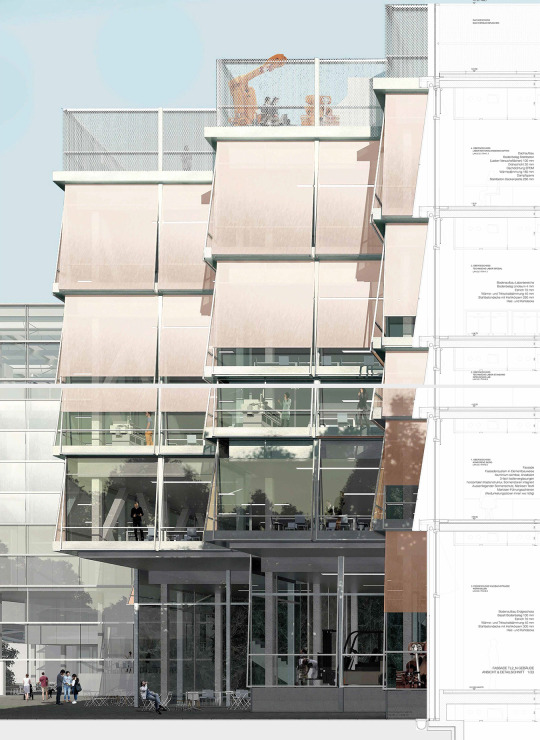

© xaveer de geyter - new zhaw laboratory buildings - winterthur, switzerland
176 notes
·
View notes
Text

Interdependency generates specificity for an urban landscape and fosters relationships in the revalorised continuüm. Expression is found in the materialisation of light as a metaphorical guide throughout an architectural project.
~Fragment of a series of visualisations on a pavillion reflecting on relationships though time. Looking back, looking forward, peace in wartimes. Mental space is enlightened. Part of a student project by Ar. Kimberly Wouters for UAntwerpen 2020.
#architecture#cultural heritage#architect#architecture colleges#architecture elements#architecture aesthetic#architecture art#architecture concept#architecture drawing#architecture lovers#architecture projects#buildings#modern architecture#play of light#mental space#archiviz#photoshop art#conceptual architecture#Belgian Architect#Studio Kultuurscape#Architect Kimberly Wouters
1 note
·
View note
Photo

Wenzel Coebergher - Preparations for the martyrdom of St Sebastian - 1599
oil on canvas, height: 288.5 cm (113.5 in); width: 207.5 cm (81.6 in)
Museum of Fine Arts of Nancy, France
Wenceslas Cobergher (1560 – 23 November 1634), sometimes called Wenzel Coebergher, was a Flemish Renaissance architect, engineer, painter, antiquarian, numismatist and economist. Faded somewhat into the background as a painter, he is chiefly remembered today as the man responsible for the draining of the Moëres on the Franco-Belgian border. He is also one of the fathers of the Flemish Baroque style of architecture in the Southern Netherlands.
Born in Antwerp, probably in 1560 (1557, according to one source), he was a natural child of Wenceslas Coeberger and Catharina Raems, which was attested by deed in May 1579. His name is also written as Wenceslaus, Wensel or Wenzel; his surname is sometimes recorded as Coberger, Cobergher, Coebergher, and Koeberger.
Before being known as an engineer, Cobergher began his career as a painter and an architect. In 1573 he started his studies in Antwerp as an apprentice to the painter Marten de Vos. Following the example of his master, Cobergher left for Italy in 1579, trying to fulfil the dream of every artist to study Italian art and culture. On his way there he stayed briefly in Paris, where he learned about his illegitimate birth from seeing the will of his deceased mother. He returned to Antwerp right away to settle some legal matters relating to this discovery. Later in the year, he set forth again to Italy. He settled in Naples in 1580 (as attested by a contract) and remained there till 1597.
In Naples he worked under contract for eight ducats together with the Flemish painter and art dealer Cornelis de Smet. He returned briefly to Antwerp in 1583, buying goods with borrowed money for his second trip to Italy. He is mentioned again in Naples in 1588. In 1591 he allied himself with another compatriot, the painter Jacob Franckaert the Elder (before 1551–1601).
He moved to Rome in 1597 (as attested in a letter to Peter Paul Rubens by Jacques Cools). During that time he had also been preparing a numismatic book in the tradition of Hendrik Goltzius. He must also have built up a reputation as an art connoisseur, since in 1598 he was asked to make an inventory and set a value on the paintings of the deceased cardinal Bonelli.
After the death of his first wife Michaela Cerf on 7 July 1599, he married again, four months later and at the age of forty; his second wife was Suzanna Franckaert, 15-year-old daughter of Jacob Franckaert the Elder, who was also active in Rome. He would have nine children with his second wife, while his first marriage had remained childless.
During his stay in Rome Cobergher became much interested in the study of Roman antiquities, antique architecture and statuary. He was also much interested in the way in which Romans represented their gods in paintings, bronze and marble statues, bas-reliefs and on antique coins. He gathered an important collection of coins and medals from the Roman emperors. These drawings and descriptions were gathered in a set of manuscripts, two of which survive (Brussels, Royal Library of Belgium). He was also preparing an anthology of the Roman Antiquity (according to the French humanist Nicolas-Claude Fabri de Peiresc) that was never published. Sometimes the "Tractatus de pictura antiqua" (published in Mantua, 1591) has been ascribed to Cobergher, but this was based on an erroneous reading of an 18th-century catalogue.
At the same time he was witness to the completion of the dome of St. Peter's Basilica in 1590. The architecture of several Roman churches made also a deep impression on him; among them most influential were the first truly baroque façade of the Church of the Gesù, Santa Maria in Transpontina and Santa Maria in Vallicella. He would use their design in his later constructions.
During his stay in Italy he painted, under the name "maestro Vincenzo", a number of altarpieces and other works for important churches in Naples and Rome. His style is somewhat mixed, incorporating Classical and Mannerist elements. His composition is rational and his rendering of the human anatomy is correct. A few of his altarpieces still survive: a Resurrection (San Domenico Maggiore, Naples), a Crucifixion (Santa Maria di Piedigrotta, Naples), a Birth of Christ (S Sebastiana) and a Holy Spirit (Santa Maria in Vallicella, Rome). One of his best known paintings is the Martyrdom of Saint Sebastian, originally in the Cathedral of Our Lady (Antwerp), but now in the Musée des Beaux-Arts in Nancy. This painting was commissioned by the De Jonge Handboog (archers guild) of Antwerp in 1598, while Cobergher was still in Rome. His Angels Supporting the Dead Lord, originally in the Sint-Antoniuskerk in Antwerp, can now also be found in the Musée des Beaux-Arts in Nancy, while his Ecce Homo is now in the museum of Toulouse.
Cobergher died in Brussels on 23 November 1634, leaving his family in deep financial trouble. His properties in Les Moëres had to be sold, as well as his house in Brussels. Even his extensive art and coin collection was auctioned off for 10,000 guilders.
59 notes
·
View notes
Text
Altaplana
Altaplana: The Game of the Obscure Cities, Les Jeux Obscurs, 2002
Altaplana is "the impossible & infinite game of the World of the Obscure Cities". It chronicles a continent full of city-states, each with their own architectural style, on a counter-Earth. The world has its own year count (AT, After the Tower), its own planets, and a connection to our own world - one of which is apparently in Brussels. Lucky Belgians. For those who are wondering, this is indeed the same world you'll find if you search for Les Cités Obscures online.
The setting is extensive. You're going to have to read through the first 160 pages of the book (out of 208) more than once or take notes in order to keep track of all the names. I'm not sure I'd be able to really do the world justice for someone who's a big fan of it. The World of Obscure Cities is described in great and varying detail - sometimes ten words will be spent on a whole city; other times a hundred will be used on a single ride in an amusement park. People from all walks of life are included, though all of them appear to be white.
There is a lot of art to support all of this. The books are published in an old enough manner that they have 32 color plates in them rather than being all-color or all-greyscale. Said plates are used for drawing after drawing of the cities, their architecture, and their citizens. The cityscapes really give you a feel for the setting. I think most (maybe all?) of the art comes from the original graphic novels, but it's still well-used.
The remaining 48 pages are the rules and a short sample adventure. Alta Plana uses a custom rule system, fairly simple, percentile-based, skill-oriented, a little similar to Call of Cthulhu. My favorite bit is how it handles "hobby" skills - they're not so much something you roll to succeed at as something to bring your hobby into relevance. Neat touch. It's not a particularly deep system, but it's stable and easy to mod. Several pages in the rules sections are one-page optional rules addons, which is a neat way to do it. The sample adventure is 6 pages, consisting of travel from the city of Blossfeldtstad to the city of Calvani, a mystery to be solved along the train, and a child to be protected from shadowy figures tailing her. A lot is left in the hands of the GM.
The book has an assumption of... not heroism, but at least interest from the PCs, so the book doesn't spend a lot of word count talking about how the group gets together. It also assumes that the game will be mostly episodic, a series of vignettes that may or may not have recurring player characters.
My understanding is that the original creators of the comics approved of the game but didn't have much to do with its creation. The French version is easier to find, but there is an English translation. It was mostly distributed in Quebec. These days a copy in good shape goes for about $300 Canadian on the used market.
#rpg#indie ttrpg#imaginary#ttrpg#jdr#imaginaire#games that don't exist about worlds that don't exist but the graphic novels about the worlds do exist
2 notes
·
View notes
Text
Natural beekeeping has arisen alongside a broadening sense of bee intelligence. People have always known that the creatures are remarkable. “The discovery of a sign of true intellect outside ourselves procures us something of the emotion Robinson Crusoe felt when he saw the imprint of a human foot on the sandy beach of his island,” Maurice Maeterlinck, a Belgian playwright and bee scholar, wrote of bees in 1901. “We seem less solitary than we had believed.”
The Mayans worshipped Ah-Muzen-Cab, the god of bees and honey. In Lithuanian, a verb meaning “to die” is reserved for humans and bees. Like us, bees practice architecture and their own, presumably less debased, form of democracy. In 1927, Karl von Frisch, an Austrian zoologist, explained the waggle dance, for which he later won the Nobel Prize. “The bee’s life is like a magic well: the more you draw from it, the more it fills with water,” he wrote. And the water has only kept rising. In 2018, researchers showed that bees understood the concept of zero—an ability previously thought to be limited to parrots, dolphins, primates, and recent humans. (Fibonacci introduced zero to Western mathematics around the year 1200.) When I spoke to Seeley, he was running an experiment on the importance of bee sleep at a research station in the Adirondacks. “It’s not just an energy-saving process,” he explained. “It really improves their cognitive abilities.” A bee’s brain is the size of a sesame seed.
5 notes
·
View notes
Photo

For a long time the work of architect, designer and artist Lucien Engels (*1928) very much unknown outside of Belgium. A student of Louis-Herman de Koninck and Victor Bourgeois at La Cambre in Brussels Engels developed a comprehensive vision of a contemporary lifestyle that integrated architecture, furniture and art. With great sensitivity Engels designed modernist yet sensual houses, apartment buildings and furniture. His magnum opus nonetheless is the „Home Emile Vandervelde II“ in Oostduinkerke, a holiday resort completed in 1957 and a total work of art for which Engels also designed furniture and murals and also involved other artists. e.g. Jan Cox who realized a 35 meter long mural.
A comprehensive overview of Lucien Engels’ rich oeuvre provides the present catalogue, written by Geert Bekaert and Mil De Kooning and published by Urban Gent in 2010: it contains a thorough biographical essay on the architect by Bekaert, followed by four case studies of his most important projects: the aforementioned „Home Emile Vandervelde II“, the Lambiotte and Lauwers houses, the Emile Vandervelde II house and his stunning own house. Extensively illustrated with plans, drawings and photographs and competently explained by Mil De Kooning the reader easily understands the irresistible appeal of Lucien Engels’ architecture and details. In the following chapters the authors shed light on his furniture designs, his collaboration with other artists as well as his own artistic output that amalgamates influences of Paul Klee, Primitivism and traditional Asian art.
Being a bilingual (NL/EN) edition the present catalogue provides a richly illustrated and very insightful overview of the work of an important Belgian architect also to an international audience. Very worth exploring!
17 notes
·
View notes
Photo

Studio for Belgian artist Stief Desmet / Graux & Baeyens Architecten ______ #architect #architecture #illustration #project #beautiful #drawing #picture #art #design #contemporaryart #nature #visual #graphic #digitalart #rendering #3ds #render #perspective #architecturerender #architecturevisualization #architecturaldrawing #concrete #collage #minimalism #knoll #neutra #vitsoe #dieterrams #peterzumthor #chairdesign https://www.instagram.com/p/CiXEIQ3t-Xg/?igshid=NGJjMDIxMWI=
#architect#architecture#illustration#project#beautiful#drawing#picture#art#design#contemporaryart#nature#visual#graphic#digitalart#rendering#3ds#render#perspective#architecturerender#architecturevisualization#architecturaldrawing#concrete#collage#minimalism#knoll#neutra#vitsoe#dieterrams#peterzumthor#chairdesign
2 notes
·
View notes
Text
IRIS VAN HERPEN: OUTWARD FASCINATION

Deferred from how it was published in A*Desk
The 21st century has given us some of the most remarkable encounters between design and technology. Few fashion shows in this regard are as memorable as Alexander McQueen‘s Spring/Summer 1999, where the designer began to showcase some of the early scenarios of convergence between these two disciplines - and the (not so) incipient threat of the technological – something that would be evoked once again in his final catwalk Plato’s Atlantis (2010).
Certainly this is not something that happens from the late 20th century, since the relationship between fashion and technology it’s always been close: design is certainly hitherto linked to it. Think of designers like Pierre Cardin and his incorporation of plastic and sculpturality in the ‘60s. Similarly, in the early 2000s, the first fashion shows by Turkish designer Hussein Chalayan revealed a marked interconnection with different nuances of technology, something that would increase in the subsequent years. Both examples illustrate how what we now remember as low tech, and therefore technology itself, has always been linked to clothing.

Iris Van Herpen, Snake Dress (2010), Dewi Driegen by Duy Quoc Vo for V Magazine Online
On this occasion, the decorative arts museum of Paris proposes in "Sculpting the Senses" an exhibition dedicated to the fragmentary universe of Dutch designer Iris Van Herpen, with a focus on her haute couture work, something in my opinion its reductive and non-assertive.
Despite these precedents, Van Herpen's style is different: her vision for the future seems at a surgical level. Her aesthetic approach edges on asceticism, exhibiting a visual purity that reflects a deep exploration of the most contemporary architectural language. There seems to be no place for the rawness of certain organic materials; it must be from this desire that the synthetic verses towards water and wind emerge.
This approach is not limited only to technique and execution based on parametric architecture, characterized by its fluidity, fragmentation, and changing patterns, but also extends to the conceptualization of her creations. Van Herpen is known for her ability to draw inspiration from diverse sources, achieving captivating results and exploring avant-garde themes beyond the traditional conventions of fashion.

Iris Van Herpen, Quaquaversal (2016). Photo: Morgan O’Donovan
But the operating room is primarily dark - from a museographic standpoint - the designer is presented to us as an enigma, whose creativity will only be accessible through another process but semiological recognition, as if replicating a reverse engineering process concerned.
The curation proposed exposes us to the work of the designer, juxtaposed with various art and design objects, attempting to explain the sources of inspiration and where relationships there emerge. In this solipsistic process, all historical antecedents, such as the previously mentioned works of Chalayan or McQueen (with whom this latter the dutch designer took her first steps), are eradicated.
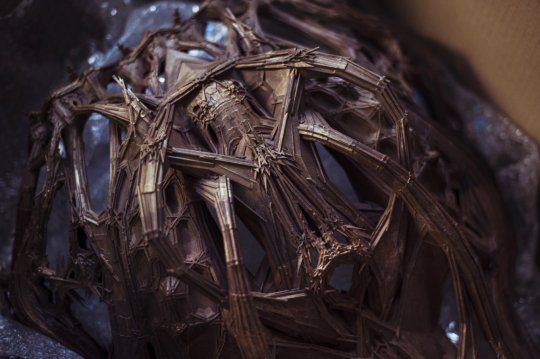
Iris Van Herpen, Cathedral Dress (2012). Photo: Morgan O’Donovan
Sculptures like "Nautilus Penta" (2023) from the Belgian artist Wim Delvoye, where Gothic cathedrals overlapped are used as minimal units (as is customary in his style), and in this case, twisted to replicate the shell of the mollusk from which it takes its name, is contrasted with the "Cathedral Dress," presented in the spring collection of 2012. A similar process is carried out, perhaps one of the more linear relationships in this effort to point out possible influences.
Throughout the exhibition, there is an attempt to desensitize the spectators, a quest to intoxicate the senses, altering perception with a disturbing sound installation: an endeavor to materialize a synesthetic effect, referring not only to Van Herpen's own condition but also to the themes of her seasons "Seijaku" (Autumn/Winter 2017), where she explores the aesthetic potential of cymatics, studying the visual evolution of sound waves as geometric patterns, and "Sensorie Seas" (Spring/Summer 2020), where the neuroscientific theories of Santiago Ramón y Cajal converge with his structural drawings of the nervous system, compared to patterns presented by different types of cnidarians and mycelia.

Iris Van Herpen, Entangled Life Dress (2021). Photo: Myrthe Giesbers
Considering precisely the dynamism and vibrational sensations evoked by the use of garments, the decision to almost completely eliminate movement in the exhibition of the pieces is quite controversial - another major misstep in museography - when clearly this is their core requirement.
Certainly, this motile dimension is essential from the inception of her work, as can be seen in designs from her Spring/Summer 2010 collection, something replicated in the sculptures of Kate McGuire and Juliette Clovis.
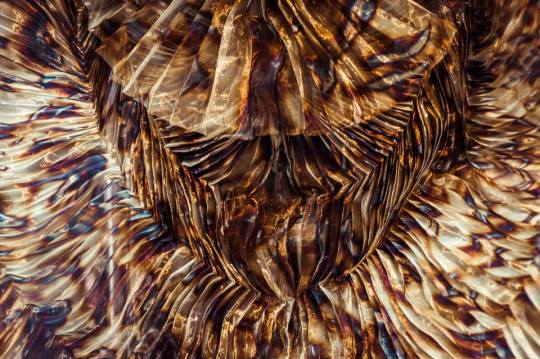
Iris Van Herpen, from Hacking Infinity (2016). Photo: Morgan O’Donovan
This characteristic bestowed by weightlessness is essential in Van Herpen's work, where a prolific oceanic style can be recognized. Recognizable references such as the silhouettes evoked by Alexander McQueen in his aforementioned show "Plato's Atlantis", indicate that the aquatic relationship is not the only one that interests the designer; rather, it encompasses any anti-gravitational connection, any dynamism of form that may be related to challenging entropic conceptions (in a strictly physical sense). Contrasting with the stiffness and heaviness of other designs that clearly reference processes of crystallization and fossilization.

Between Music Group performance during catwalk Aeriform (2017). Photo: Morgan O’Donovan
Van Herpen's universe is undoubtedly a synthetic convergence between the forces of nature and cultural process, reorganizing and rearranging codes and social orders in a style where crinoids and ruffs can couple to give birth to an intricate artificial mesoglea*. A symbiosis of high technology and the craftsmanship of haute couture emerging from embroideries reinterpreting mycelial patterns.
In the development of three-dimensional appendages, even coated in latex to mimic skins of mythological creatures, cochlear forms or liquid metals, this subjects created by Iris Van Herpen are cyborgs of distant bodies. Virtual boundaries are evoked in a pulsating, centrifugal, outward fascination, from which sensory barriers are ejected. This virtuality functions as a holographic, mutable boundary, both technological and biological: a limit that can be an embrace as well as a weapon.
_______________________________________
*The mesoglea is the mainly watery tissue that serves as a hydrostatic skeleton in animals of the phylum Medusozoa (jellyfish)
#iris van herpen#design#fashion#mode#adesk#gonzalopech#artcritic#art#art critique#art criticism#neederlands
0 notes
Text
A Visitor's Handbook to Portland Top Attractions

Fore Street
Fore Street is a well-known destination for food enthusiasts in Portland. This bustling street is home to a plethora of restaurants and eateries, offering a diverse range of culinary delights. Whether you are craving fresh seafood, international cuisine, or traditional American fare, Fore Street has something for everyone. The vibrant atmosphere and charming ambiance make it an ideal spot for a memorable dining experience.
With its location in the heart of the Old Port, Fore Street also offers visitors a chance to explore the rich history and culture of Portland. Strolling along this historic street, you'll find charming brick buildings, quaint shops, and art galleries. The lively energy of Fore Street is contagious, as locals and tourists alike wander the sidewalks, taking in the sights and sounds of this vibrant neighborhood. Whether you're a foodie or a history buff, Fore Street is a must-visit destination in Portland.
Allagash Brewing Company
The Allagash Brewing Company, located in Portland, Maine, is a well-known and highly regarded craft brewery. With its roots dating back to 1995, Allagash has become a staple in the New England craft beer scene. Brewing a wide array of Belgian-inspired ales, Allagash is known for its commitment to quality and innovation.
One of Allagash Brewing Company's flagship beers is the Allagash White. This Belgian-style wheat beer is brewed with a unique blend of spices, including coriander and Curacao orange peel, giving it a refreshing and citrusy flavor profile. Another popular offering from Allagash is the Tripel, a strong golden ale with complex flavors of fruit and spice. With a dedication to traditional brewing techniques and a passion for experimentation, Allagash Brewing Company continues to push the boundaries of what can be achieved in craft beer.
Victoria Mansion
Located in Portland, Maine, the Victoria Mansion is an iconic historical landmark that draws visitors from near and far. Stepping foot into this exquisite mansion is like taking a journey back in time to the Victorian era. With its stunning architecture, elegant interiors, and richly decorated rooms, the Victoria Mansion provides a glimpse into the opulent lifestyle of the wealthy in the 19th century.
The Mansion's exterior facade, adorned with intricate details and elaborate ornamentation, immediately captures the attention of visitors. The grand entrance, with its imposing double doors and graceful staircase, sets the tone for the splendor that awaits inside. As you explore the rooms, you will be mesmerized by the meticulously restored furnishings, vibrant wallpapers, and intricately designed moldings. Each room tells a story of the past, showcasing the craftsmanship and exquisite taste that defined the Victorian era. Whether you are an architecture enthusiast, history buff, or simply curious about the past, the Victoria Mansion offers a captivating experience that is sure to leave a lasting impression.
Portland Observatory
Perched on Munjoy Hill, the Portland Observatory offers visitors a captivating glimpse into the maritime history of Portland, Maine. Erected in 1807, this historic tower served as a communication and navigation tool, enabling ship captains to identify vessels approaching the harbor. Standing at 86 feet tall, the Observatory provided an unparalleled vantage point over Casco Bay, assisting in the coordination of ship traffic and ensuring the safe arrival and departure of vessels.
The Observatory's structure is a testament to the architectural ingenuity of its time. Built with a cylindrical design, the tower features a spiral staircase leading to an observation deck offering panoramic views of the city and the surrounding waters. With its original wooden exterior and distinctive cupola crowning the top, the Portland Observatory stands as a cherished reminder of Portland's maritime heritage, having outlasted numerous storms and even a devastating fire in 1866. Today, visitors can explore this captivating landmark, delving into the rich history that shaped Portland's role as a bustling seaport.
Maine Historical Society and Museum
The Maine Historical Society and Museum holds a wealth of information about the history and heritage of Maine. With its extensive collection of artifacts, documents, and artworks, visitors can explore the state's rich past and gain a deeper understanding of its cultural identity. The society's mission is to preserve and share the history of Maine, making it accessible to the general public through exhibitions, educational programs, and research opportunities.
Within the walls of the museum, visitors can immerse themselves in the stories of the past. From exhibits showcasing the indigenous peoples who first inhabited the land, to displays on the significant events and figures that shaped Maine's history, there is something for everyone to discover. The museum also houses a comprehensive library and archives, making it a valuable resource for researchers and scholars interested in delving deeper into Maine's fascinating past. Whether you are a history enthusiast, a student, or simply curious about the state's heritage, the Maine Historical Society and Museum offers a captivating journey into the past.
Hiring a cleaning service during or after your vacation in Portland, ME is a strategic decision that can significantly enhance your overall experience. Portland is a destination known for its picturesque landscapes, vibrant city life, and numerous outdoor activities, leaving visitors with little time or inclination to worry about household chores. By engaging a professional cleaning service, you not only ensure a seamless return to a tidy and welcoming home environment but also extend the relaxation of your vacation. Allow yourself the luxury of extra time to explore the city's charming streets, indulge in local cuisine, and soak up the coastal beauty without the stress of post-travel cleaning tasks. With a cleaning service, you can effortlessly transition from vacation mode to the comfort of a pristine living space, making your time in Portland all the more enjoyable and carefree.
Contact:
Cleaners Joy
https://www.cleanersjoy.com/
63 Federal St, Portland, ME 04101
(207) 687-1705
0 notes
Text
DECONSTRUCTION DESIGNER RESEARCH- REI KAWAKUBO

Rei Kawakubo of Comme des Garçons is one of the most visionary and influential designers working today. For nearly five decades, she has defied convention to redefine fashion. Her designs have subverted garment shape and function, reframed ideas of beauty, and proposed a new relationship between body and dress.

I found it really interesting how Kawakubo was committed to offering women, comme des garçons (“like boys”), clothes designed for mobility and comfort. For this reason, she never designed stilettos or had her models wear them on the runway. Her clothes were designed for the independent woman who did not dress to seduce or gain a man’s approval. She found revealing clothing decidedly unsexy and boring.

Over the past past eight seasons, since her spring/summer 2014 show, Kawakubo has unveiled her arguably most radical concept. That collection focused on the idea of “objects for the body,” and signified a move away from clothing — and into abstract realms. Kawakubo has bluntly described this is a shift from clothes to “not clothes.”
Kawakubo had shown sweaters intentionally knitted with holes, created by loosening screws in the knitting machinery, impeding the construction process. She garnered the label “the mother of deconstruction” (the Belgian Martin Margiela is generally dubbed the father). Even when creating her latest collections of “not clothes,” the elaborate methods of construction frequently draw on tailoring traditions and dressmaking tactics. A knowledge of the architecture of garments underpins all Comme des Garçons creations.
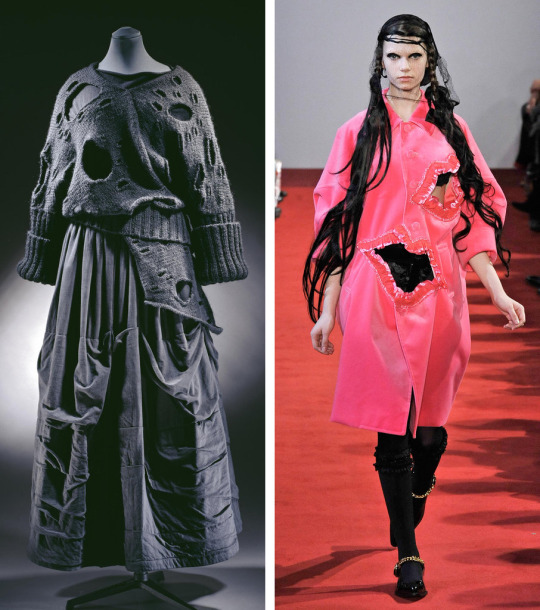
SPRING COLLECTION 2021
As vogue stated: Kawakubo has been striving to arrive at a creative resolution for designing in the midst of the existential plight that we’re all suffering. Dissonance was her theme, explained thus: “The human brain always looks for harmony and logic. When logic is denied, when there is dissonance a powerful moment is created which leads you to feel an inner turmoil and tension that can lead to finding positive change and progress.”
Reading this quote from Kawakubo made me think about how when you take away the logic of your designs and stop focusing on perfection, it can actually give you more ideas than you are aware of. Taking the time to deconstruct your pieces and work with a process will bring you a much better outcome than thinking towards your final pieces.



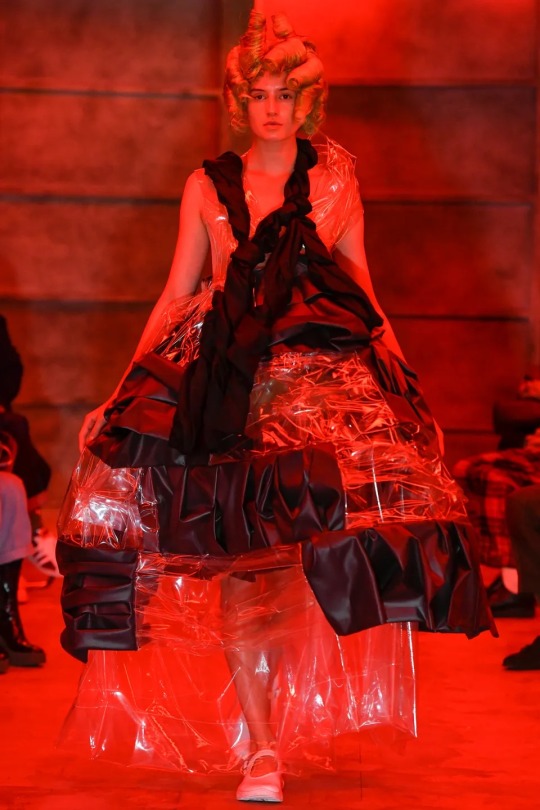


1 note
·
View note
Photo

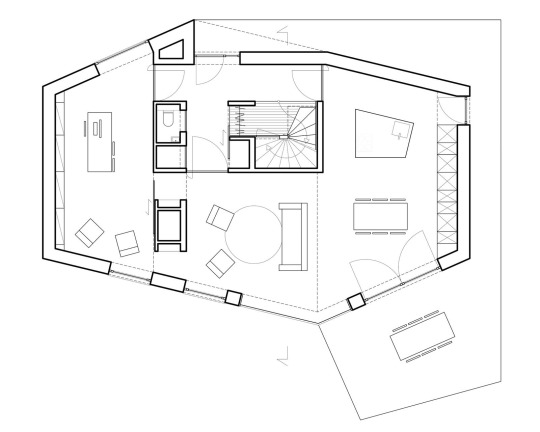

© dedal architectes - house on a corner plot - nethen, belgium
76 notes
·
View notes
Text


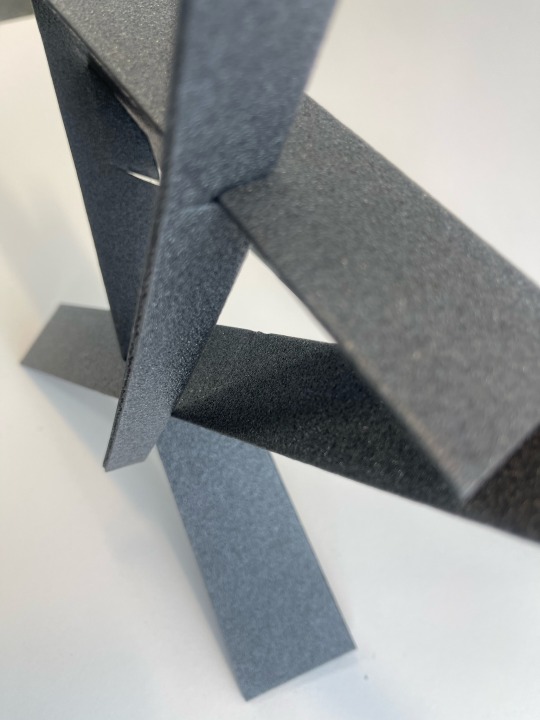





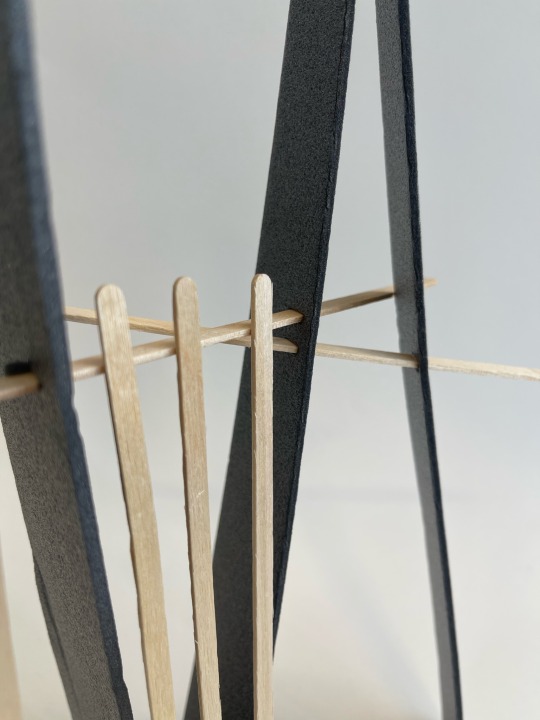

FMP: Contemporary/Modern/Brutalist Architecture
Ideas - I feel that there’s always a way to make everyday buildings look more advanced, more unique or even just better represent the work going on inside. With this in mind I got to work on putting together a very basic, very abstract yet unique structure for what could potentially be an office building, I made two versions of this so I decided to post both.
The next to the abstract designs for office building was a basic design for a highway going through mountains, although this design isn’t exactly environmentally friendly it was an idea that I explored where I was trying to find a way to improve travel in terms of designing highways through places where it’s difficult to travel through, this can help with the exports of goods through difficult terrain.
Artist Research:
The first picture is from a site called e-architect.com (I’ll put the link below) and it shows the Antwerp courthouse, also I couldn’t make spikes I had to improvise but the concept of having parts of a building jutting out is where I got my inspiration from.
Link for website:
https://www.e-architect.com/belgium/antwerp-law-courts
I believe the photographer who took the picture of this highway is Anthony Alaniz and the highway itself is located in Guizhou, a province nestled in the southwestern part of China surrounded but tough terrain and mountains.
I draw my inspiration from this photograph because I can visualise the shortcuts that could be possible with roads going through mountains instead of going round the side.
1 note
·
View note
Photo
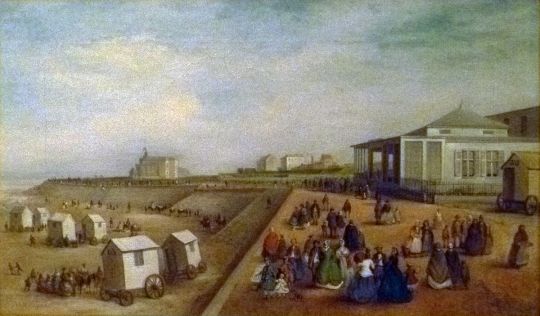
Michel Van Cuyck - Beach of Oostende - ca 1866
Collection of the City of Oostende
Michel Thomas Antonius Van Cuyck (19 August 1797, Ostend - 10 May 1875, Ostend) was a Belgian painter, watercolorist and lithographer.
From 1811 to 1817, he studied at the Bruges Academy of Fine Arts . After graduating, he set up a studio in Oostende, but was forced to supplement his income by painting houses. In 1820, he and François-Antoine Bossuet co-founded the "School voor Teeken- en Bouwkunde" (School for drawing and architecture). They had several students who became well known, including Edgar Baes , Lionel Baes , François Musin and, especially, James Ensor. The latter, however, was not impressed by what he described as the "deceptive sponge and drawing technique of this dull, boring and stillborn business".
In 1827, a blue whale washed up on the beach near Ostend. Van Cuyck made a series of paintings, depicting it on the beach, and drawings of the dissection process, which accompanied an exhibition of the whale's skeleton. It was purchased by a local philanthropist named Herman Kessels who toured with it and Van Cuyck's drawings for almost four decades. Since 1865, it has been on display at the Russian Academy of Sciences in St. Petersburg.
During the years following independence, King Leopold I transformed Oostende into a sort of Royal Residence, which developed into a fashionable seaside resort. Van Cuyck was one of the first to depict the tourism and the bathing culture there. His beach scenes and seascapes are now some of his most familiar works. He also painted Flemish fairs and landscapes, primarily in Walloon Brabant, in Biedermeier style. His portrayal of Queen Louise on her deathbed was reproduced as a lithograph.
He was the first in a long line of painters, which included his sons, Edouard-Johannes Van Cuyck (1828-1893) and Michel Thomas Séraphin Van Cuyck (1822-1890), as well as his grandsons, Michel-Julien Van Cuyck (1861-1930), Octavius-Ludovicus Van Cuyck [nl] (1870-1956) and Paul-Edouard-Alphonse Van Cuyck (1882-?).
9 notes
·
View notes
Photo

Groeipijn
Growing pains
#illustratie#tekening#drawing#Illustration#collage#digital illustration#pendrawing#handdrawn#belgian illustrator#madeinantwerp#growing#city#Architecture
5 notes
·
View notes
Photo

By François Schuiten.
#image#images#drawing#illustration#book#ghost#people#architecture#comics#bande dessinée#belgian artist#françois schuiten
239 notes
·
View notes
Photo


Drawing from a photo I took when in Brugges, Belgium, 2018.
#art#drawing#watercolor#painting#traditional art#belgium#urban sketch#architecture#belgian architecture#brugges#women in animation#line and color
8 notes
·
View notes